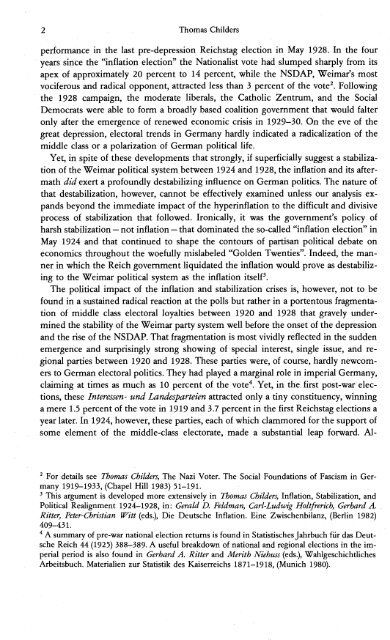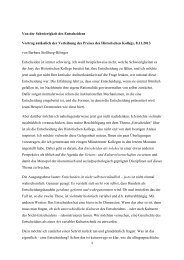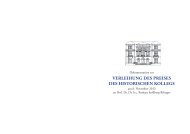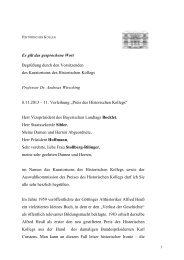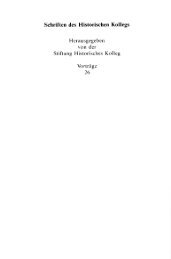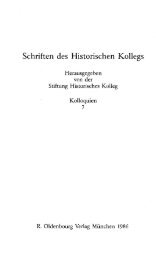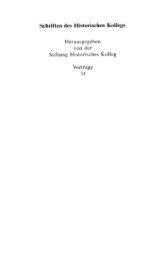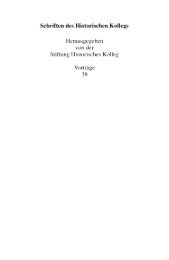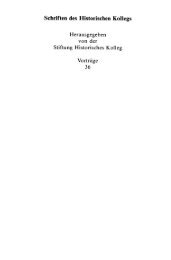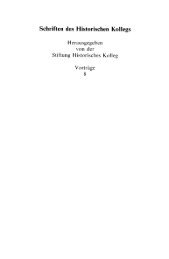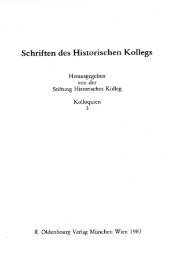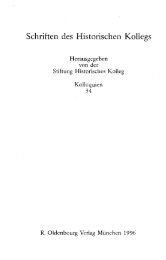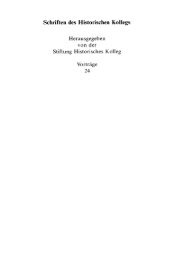Schriften des Historischen Kollegs - Kolloquien 6 - Historisches Kolleg
Schriften des Historischen Kollegs - Kolloquien 6 - Historisches Kolleg
Schriften des Historischen Kollegs - Kolloquien 6 - Historisches Kolleg
Erfolgreiche ePaper selbst erstellen
Machen Sie aus Ihren PDF Publikationen ein blätterbares Flipbook mit unserer einzigartigen Google optimierten e-Paper Software.
2 Thomas Childers<br />
performance in the last pre-depression Reichstag election in May 1928. In the four<br />
years since the "inflation election" the Nationalist vote had slumped sharply from its<br />
apex of approximately 20 percent to 14 percent, while the NSDAP, Weimar's most<br />
vociferous and radical opponent, attracted less than 3 percent of the vote 2 • FoIlowing<br />
the 1928 campaign, the moderate liberals, the Catholic Zentrum, and the Social<br />
Democrats were able to form a broadly based coalition government that would falter<br />
only after the emergence of renewed economic crisis in 1929-30. On the eve of the<br />
great depression, electoral trends in Germany hardly indicated a radicalization of the<br />
middle dass or a polarization of German political life.<br />
Yet, in spite of these developments that strongly, if superficiaIly suggest a stabilization<br />
of the Weimar political system between 1924 and 1928, the inflation and its aftermath<br />
did exert a profoundly <strong>des</strong>tabilizing influence on German politics. The nature of<br />
that <strong>des</strong>tabilization, however, cannot be effectively examined unless our analysis expands<br />
beyond the immediate impact of the hyperinflation to the difficult and divisive<br />
process of stabilization that foIlowed. IronicaIly, it was the government's policy of<br />
harsh stabilization - not inflation - that dominated the so-caIled "inflation election" in<br />
May 1924 and that continued to shape the contours of partisan political debate on<br />
economics throughout the woefuIly mislabeled "Golden Twenties". Indeed, the manner<br />
in which the Reich government liquidated the inflation would prove as <strong>des</strong>tabilizing<br />
to the Weimar political system as the inflation itself3.<br />
The political impact of the inflation and stabilization crises is, however, not to be<br />
found in a sustained radical reaction at the polIs but rather in a portentous fragmentation<br />
of middle dass electoral loyalties between 1920 and 1928 that gravely und ermined<br />
the stability of the Weimar party system weIl before the onset of the depression<br />
and the rise of the NSDAP. That fragmentation is most vividly reflected in the sudden<br />
emergence and surprisingly strong showing of special interest, single issue, and regional<br />
parties between 1920 and 1928. These parties were, of course, hardly newcomers<br />
to German electoral politics. They had played a marginal role in imperial Germany,<br />
daiming at times as much as 10 percent of the vote 4 • Yet, in the. first post-war elections,<br />
these Interessen- und Lan<strong>des</strong>parteien attracted only a tiny constituency, winning<br />
a mere 1.5 percent of the vote in 1919 and 3.7 percent in the first Reichstag elections a<br />
year later. In 1924, however, these parties, each of which dammored for the support of<br />
some element of the middle-dass electorate, made a substantial leap forward. AI-<br />
2 For details see Thomas Childers, The Nazi Voter. The Social Foundations of Fascism in Germany<br />
1919-1933, (Chapel Hili 1983) 51-191.<br />
3 This argument is developed more extensively in Thomas Childers, Inflation, Stabilization, and<br />
Political Realignment 1924-1928, in: Gerald D. Feldman, Carl-Ludwig Holtfrerich, Gerhard A.<br />
Ritter, Peter-Christian Witt (eds.), Die Deutsche Inflation. Eine Zwischenbilanz, (Berlin 1982)<br />
409-43l.<br />
4 A summary of pre-war national election returns is found in Statistisches Jahrbuch für das Deutsche<br />
Reich 44 (1925) 388-389. A useful breakdown of national and regional elections in the imperial<br />
period is also found in Gerhard A. Ritter and Merith Niehuss (eds.), Wahlgeschichtliches<br />
Arbeitsbuch. Materialien zur Statistik <strong>des</strong> Kaiserreichs 1871-1918, (Munich 1980).


